A Guide to Subfloor Sheathing
For a stable, flat, and squeak-free floor, you'll find that most new products are OSB.
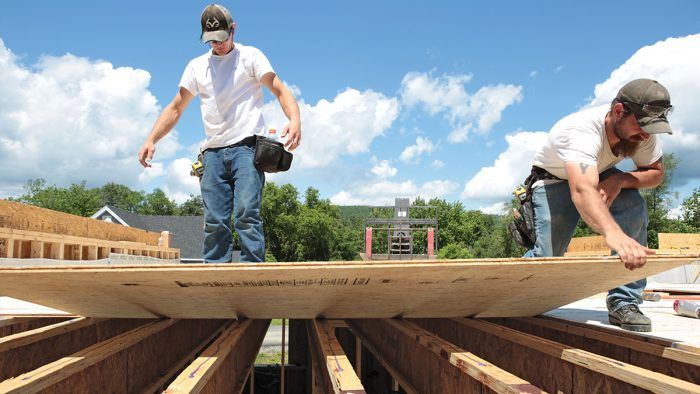
Subfloor sheathing provides stability and a stiff surface for a finished floor. Builder Fernando Pagés Ruiz discusses the popularity of OSB over plywood sheathing, sheathing panel sizes, panel testing criteria, and additional moisture-resistance measures by subfloor manufacturers. He describes five manufacturers’ offerings that involve different subfloor material and solutions for edge swelling, along with an idea of pricing.
Making the Perfect Floor
Imagine walking across a beautiful floor in a well-built home. You marvel at the character of the wood grain and the perfection of the finish. The floor feels sturdy and smooth under your feet. Though the solid wood flooring that you’re seeing and feeling gets all the glory, the secret of the system lies beneath the surface.
It starts with right-size floor joists, that deflect little and don’t bounce beneath your feet. Equally important is pairing the joist system with the right subflooring. Subfloor sheathing provides structural stability and a stiff surface to support a long-lasting finished floor. And subfloor installation matters a lot. Regular nails are hardly adequate. Most builders turn to a combination of ring-shank nails or screws and glue. In this article, however, we’re going to look at the material choices. There’s been a bit of innovation in subflooring, and it all points toward one material: oriented strand board, or OSB.
Squeaks Can Bedevil the Builder
When buying a commodity sheathing panel suitable for both floors and roofs, you will notice an ink-stamp marking on the panel that looks like a fraction, likely 24/16. This pair of numbers tells you the maximum joist spacing for which the sheathing was designed, in inches. The first number (24) applies only to using the material on a roof, and the second (16) applies to using it on a floor. Suppose you purchase conventional, commodity-grade 3/4-in. sheathing stamped 24/16 to use as a subfloor. That means you should install it on joists spaced no more than 16 in. apart and install blocking at the seams to prevent deflection along the panel edges. However, blocking is unnecessary when using tongue-and-groove panels, and all panels manufactured explicitly for use as subflooring—what we’re going to look at here—come with tongue-and-groove edges.
Although most floors have 16-in. joist spacing, the International Residential Code (IRC) offers many options when combining subfloors and joist spacings. In general, the minimum thickness for standard subflooring is 3/4 in., which can handle a load of 100 lb. per sq. ft. at 16-in. joist spacing. However, you can also use 15/32-in. or 1/2-in. subflooring to span 16-in. on-center joist spacing. And when installing a 3/4-in. solid-wood finished floor at right angles to the joists, you can use 15/32-in. or 1/2-in. subflooring and set your joists at 24 in. There are lots of options given in the IRC, but in general, thicker subflooring allows wider joist spacing.
According to a J.D. Power New-Home Builder Customer Satisfaction Survey, half of all new homeowners complain about squeaky floors. Squeaky floors often result from subfloor panels that aren’t securely fastened and move up and down on nails, making a rubbing noise. To avoid this annoyance, builders can combine subfloor adhesives with screws or deformed ring-shank nails, which are more effective at preventing movement than smooth-shank nails.
Despite these measures, floors with long spans may still experience movement and noise due to joist deflection, causing the nails that secure interior walls to the floor to rub and squeak. Bedeviling builders, this common issue persists even after attempts to fix it by refastening the subfloor. The solution is to ensure that the floor system is sufficiently rigid, particularly over long spans. Builders can achieve this on floors with long spans by opting for a more stringent deflection rate than the minimum required by the building codes. You can also specify the deflection rate when buying engineered joists or floor trusses to make sure the manufacturer is not designing to minimum specifications. Additionally, securing interior walls to the floor with screws and glue instead of nails can further reduce squeaks.
Finally, it’s important to know when you need an additional underlayment below your finished floor. Carpet and padding, hardwood, some engineered flooring, and some thicker vinyl planks can be laid directly on smooth subflooring. Thinner flooring, like most vinyl, requires an additional underlayment, usually 3/8-in. plywood, to ensure a perfectly flat finished floor. Ceramic tile often requires a cementboard underlayment. Cementboard manufacturers generally recommend a 5/8-in. subfloor, but for tiles larger than 12 in., they recommend a 3/4-in. subfloor.
A Fascinating Factory Tour
While researching this article, I was invited by the folks at Huber Engineered Wood to visit one of the mills where they make their sheathing products, including all their subflooring. Here’s a look at the production process for AdvanTech X-Factor panels, which begins with logs delivered by the truckload.
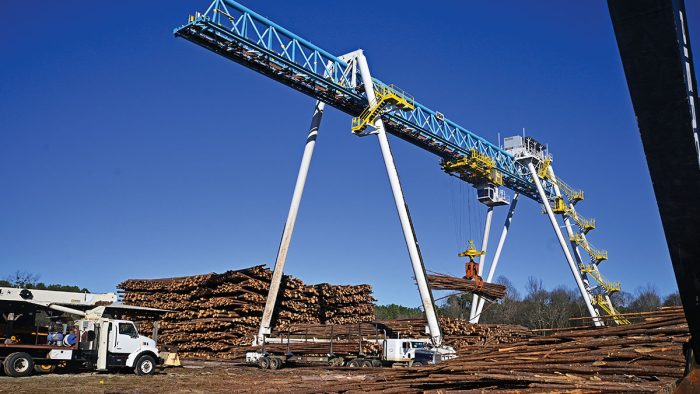
Photo by Fernando Pagés Ruiz.
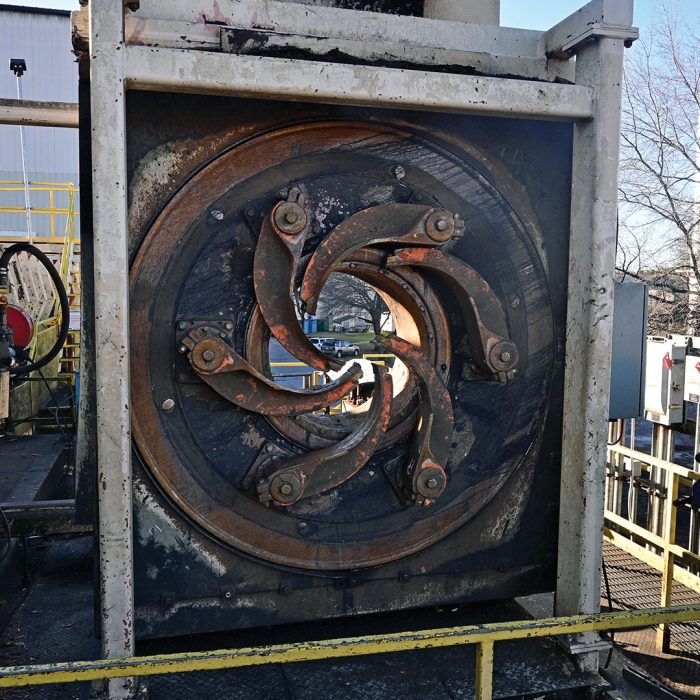 |
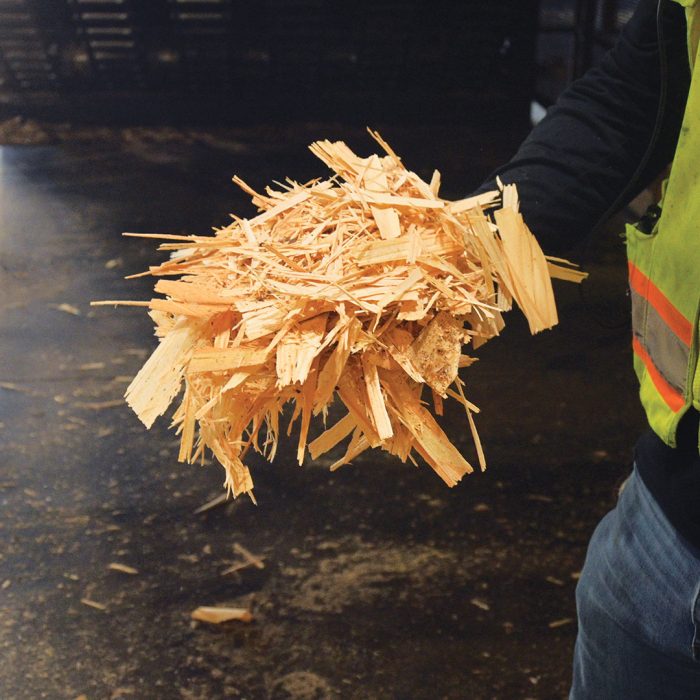 |
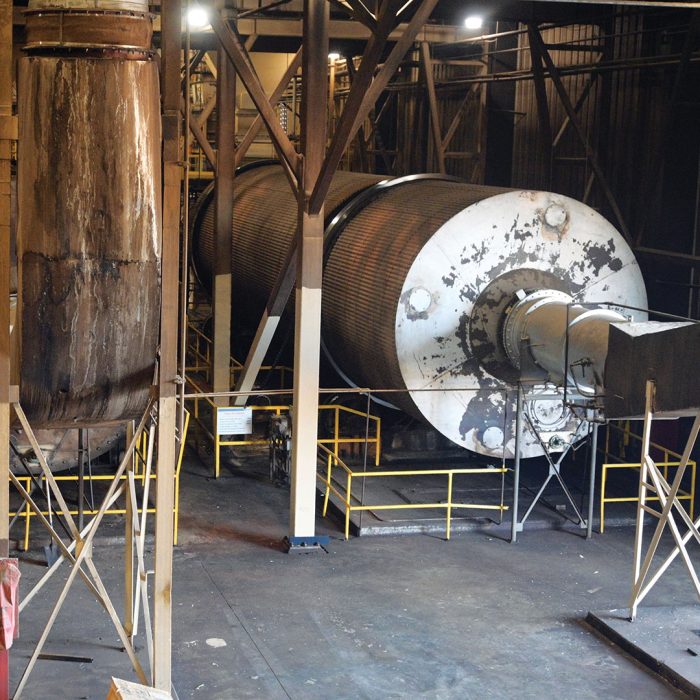 |
Ground, Baked, and Coated: Logs are passed through grinders and wood flakes are the result. The flakes are then tumbled in drums where they are dried and coated with resins and waxes. Photos by Fernando Pagés Ruiz.
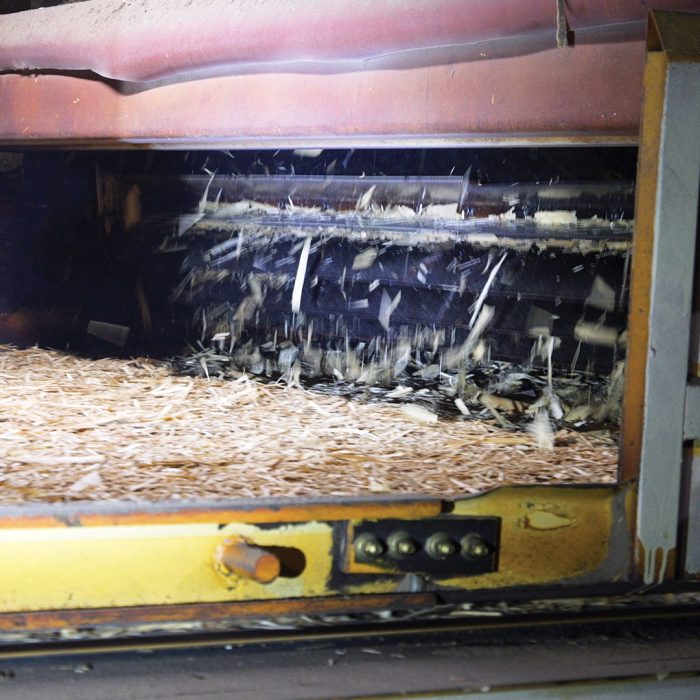 |
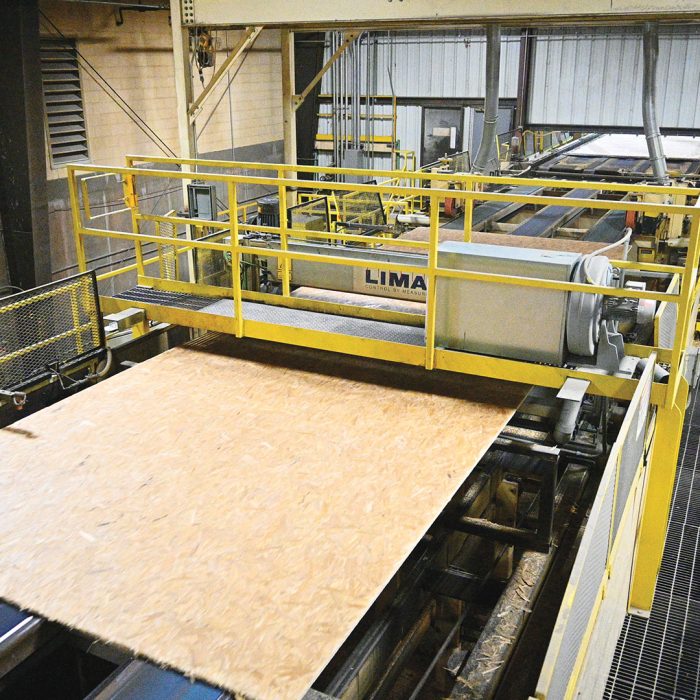 |
Pressed Into Panels: For Huber’s X-Factor panels, the water-resistive overlay is rolled out and covered with the treated flakes, then compressed to the designated panel thickness. The sheets are 24 ft. long until they are cut to their standard 4-ft. by 8-ft. finished dimensions. Photos by Fernando Pagés Ruiz.
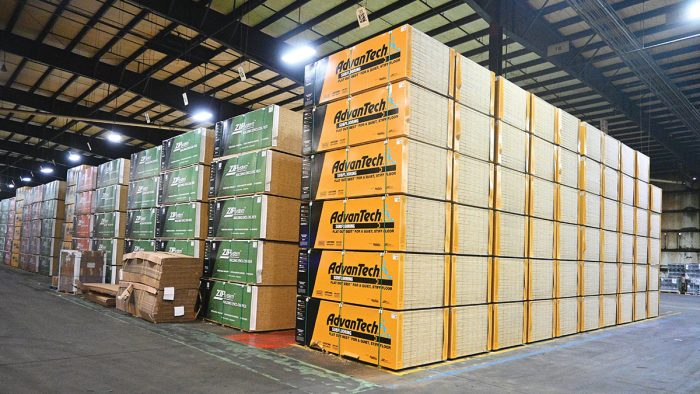
Ready to Roll: Units of all Huber sheathing products are stacked with protective covers and are ready to be loaded back onto trucks and delivered to lumberyards and home centers across the country. Photo by Fernando Pagés Ruiz.
Innovation Started with the APA
It wasn’t too long ago that most subflooring was a combination of standard sheathing panels and a second layer of plywood, as described above. Modern subflooring first evolved into a specialized material designed to serve dual roles as sheathing and underlayment when the Douglas Fir Plywood Association, which today is called the Engineered Wood Association, but known by the initials APA, developed and started marketing subflooring under the trademark Sturd-I-Floor. This designation, used by numerous commodity sheathing manufacturers, was used to label both plywood and OSB panels with a tongue-and-groove edge and a surface smooth enough to install carpet and hardwood flooring directly over.
The APA’s primary role is to ensure quality standards in the engineered wood industry. Its trademark, which appears only on products from members adhering to APA’s quality inspection and testing program, assures consumers (and building inspectors) that these products meet established manufacturing and performance criteria.
The testing protocols for Sturd-I-Floor panels are more rigorous than for standard sheathing. These tests assess performance attributes, such as resistance to distributed loads (such as kitchen cabinets installed on a continuous base) and concentrated loads (kitchen table legs). Impact tests, often called “bag drops,” evaluate the panel’s ability to withstand repeated impacts without losing structural integrity. The material is also saturated, dried, and then stressed to verify the moisture tolerance of the adhesives. Plywood panels generally have greater moisture tolerance than OSB. However, OSB Sturd-I-Floor products can take the occasional heavy rain without damage, as panels are coated with waxes to resist water.
Also tested is the panel’s fastener-holding ability, to determine the lateral (shear) and withdrawal loads required to pull out a nail. Linear-expansion tests are used to see how much a panel expands lengthwise with exposure to moisture. Builders can recognize APA-tested OSB and plywood by the APA stamp, which offers a lot of detail including the panel grade, span and exposure ratings, and thickness, and if the panel has a tongue-and-groove edge. The span rating of Sturd-I-Floor sheathing runs from 16 in. to 48 in., when spanning at least three or more floor joists.
More Water-Resistant OSB
While Sturd-I-Floor is a designation and not a specific product, today we have brand-name subflooring products to choose from, and most are OSB. Using OSB allows manufacturers to create niche products with specific price points while enhancing product performance by tweaking the chemical and mechanical properties beyond minimum industry standards. Manufacturers can create unique offerings using proprietary manufacturing processes and enhanced resins, glues, waxes, and other additives to achieve design strength and moisture resistance.
LP markets one such subfloor panel under the LP Legacy brand, an APA-certified subflooring. LP highlights enhancements such as increased stiffness and moisture resistance achieved through a higher resin and wax content than the APA standard mandates. They bind wood strands with Gorilla Glue technology, asserting superior stability and strength. Neil Freidberg, building science manager at LP’s OSB division, noted, “Our LP Legacy product achieves 69% more bending strength parallel to the strength axis than commodity subfloor, and 95% more strength perpendicular to the strength axis.” He explained, “In simple terms, Legacy’s bending strength is significantly better than a commodity panel. Step between joists and the subfloor won’t give.”
The Legacy subfloor includes rain channels on the ends of the boards to allow rainwater and melting snow to drain. LP’s more affordable TopNotch 350 subfloor has notches along the tongue that allow water to weep between boards, avoiding standing water along the seams. Their tongue-and-groove edges also feature built-in spacers that create the required expansion joint as panels interlock. Freidberg clarified, “Instead of slamming these panels together, they notch in together and lock, automatically giving you that 1/16-in. expansion gap you want, along with the 1/8-in. gaps on the ends.”
On its Legacy subflooring, LP offers a “Covered Until It’s Covered No-Sand Warranty” and a lifetime limited warranty that lasts as long as the home. This warranty means that the manufacturer is confident the panels will not swell along the edges and require sanding to plane off swollen seams. LP also offers a limited lifetime squeak-free guarantee when using LP Legacy Premium Sub-Flooring and LP Legacy Adhesive together. The adhesive expands to seal even the small gaps between panels and joists. The company recommends a bead of adhesive along the groove before inserting the tongue to solidify the joint. LP warns against overdriving the tongue into the groove, which may create a squeak not covered by warranty.
An Even More Premium Product
Huber Engineered Woods was among the first companies to introduce a premium OSB subfloor with their AdvanTech line. In 2023, they launched AdvanTech X-Factor, a new subfloor product that builds upon Huber’s Zip System wall and roof sheathing. Like Zip sheathing, AdvanTech X-Factor features a permanent water-resistive barrier laminated onto the top of the panels.
Huber developed this innovation in response to custom builders’ needs for subfloor surfaces that withstand longer construction cycles. X-Factor’s lamination is a Grade-D water-resistive barrier and Class II vapor retarder that’s embossed for traction in wet conditions. The overlay protects the material from UV light, extending the time it can remain exposed to the elements.
During a factory tour, Bill Schettler, the technical manager at Huber’s plant in Commerce, Ga., told me that consumers find the coating reassuring. Although sunlight doesn’t affect OSB’s performance, the resulting washed-out appearance it creates can cause homeowners to worry. “The finish stays bright and doesn’t fade or turn gray when exposed to the elements, which helps alleviate homeowners’ worries during site visits,” Schettler said. He also pointed out another benefit that surprised the manufacturer: Builders appreciate the product’s clean, yellow finish. “They can snap chalklines and mark plumbing and electrical locations, and they stand out,” he told me.
Schettler highlights that beneath the overlay, Huber’s panels exceed industry standards for strength, stiffness, and moisture resistance, a threshold they achieve by increasing the concentration of binders such as premium-quality phenolic resins, waxes, and high-performance methylenediphenyl diisocyanate adhesives. Pointing to large drums in the factory, Schettler said, “This is where our panels diverge from commodity sheathing. We exceed commodity standards by using more resin and better-quality water-resisting agents to coat our strands and achieve a stronger, longer-lasting panel.”
You won’t find the APA label on any Huber sheathing. They certify their products with PFS Teco, which owns several federally registered certification marks, including Floor Span, the mark on all of Huber’s subflooring. As Steve G. Winistorfer, PE, vice president of product engineering and quality, explained, “The APA takes a commodity position; they set a minimum standard that most subfloors comply with. We are not a commodity producer, so we want to stand out from that group. Teco is more aligned with specialty product manufacturers like Huber.”
According to Winistorfer, AdvanTech offers design strength 62% greater than commodity subfloor and stiffness 28% beyond the measures required by PS-2, the minimum performance standards for OSB as set by the U.S. Department of Commerce. “In the wood industry, you test materials to failure and then set the design load at one-third of that because you don’t want products to get anywhere near failure,” explained Winistorfer.
Stiffness, he continued, “refers to deflection or displacement, and it’s more of a serviceability issue, especially as it relates to finishes, such as floor tile. In testing for stiffness, the panel is nowhere close to structural failure, but maybe it flexes enough for the tiles to crack, and you don’t want that, so stiffness is important.” To ensure the durability of X-factor’s overlay, Huber performs aggressive testing, including immersion in boiling water, drying in a 220°F oven, and pull-off tests.
Huber offers a 500-day guarantee against edge swelling during job-site exposure and a no-sanding promise. However, Schettler advises care, emphasizing, “It’s wise to prevent the accumulation of standing water or snow on the subfloor for long periods.” Huber also offers a squeak-free guarantee when installing their subfloor over an engineered floor-truss system with deformed fasteners and the company’s AdvanTech adhesive.
The Choice is Yours
Plywood can also be damaged by excess moisture, but it dries quickly and often returns to its original shape. Plus, it is about 10 lb. lighter per sheet than OSB. For these and other reasons, some builders consider it a higher-quality material. At least one manufacturer, Georgia-Pacific, offers plywood subflooring for those who prefer the material. According to company literature, their DryPly subflooring is plywood treated with a water-resistant coating that promises 40% less moisture absorption than OSB.
Choosing a commodity-grade subfloor over a high-performance, premium-price branded product depends on your project and construction values. Huber’s Schettler readily admitted that AdvanTech X-Factor appeals to high-end custom builders. At the same time, Huber’s Blue Plus OSB subfloor sheathing offers a price-sensitive alternative for the builder who uses commodity panels. If you are not worried about harmless oxidation on the face of your subfloor and will not leave the panels exposed to extreme weather for extended periods, a lower-priced commodity subfloor can certainly deliver all the performance you need.
Branded Innovations in Subflooring
Sheathing has quickly evolved from solid-wood lumber to commodity plywood to commodity OSB to today’s assembly-specific, branded products. And when it comes to subflooring, these products have taken off, with OSB as the name of the game. The main concern with OSB is edge swelling. After heavy rains, exposed OSB panels can take on water along the edges. The solution has long been to sand the swollen panel joints before installing flooring, but some new OSB products are designed to prevent swelling in the first place.
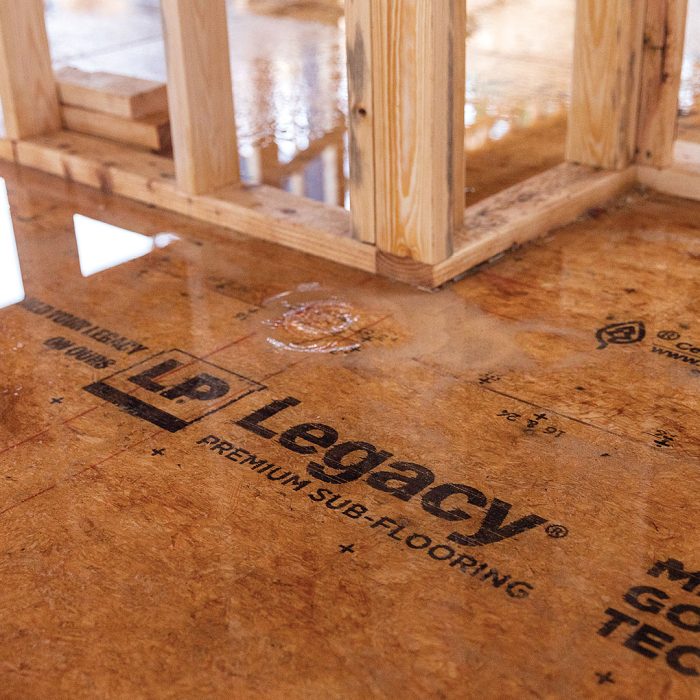 |
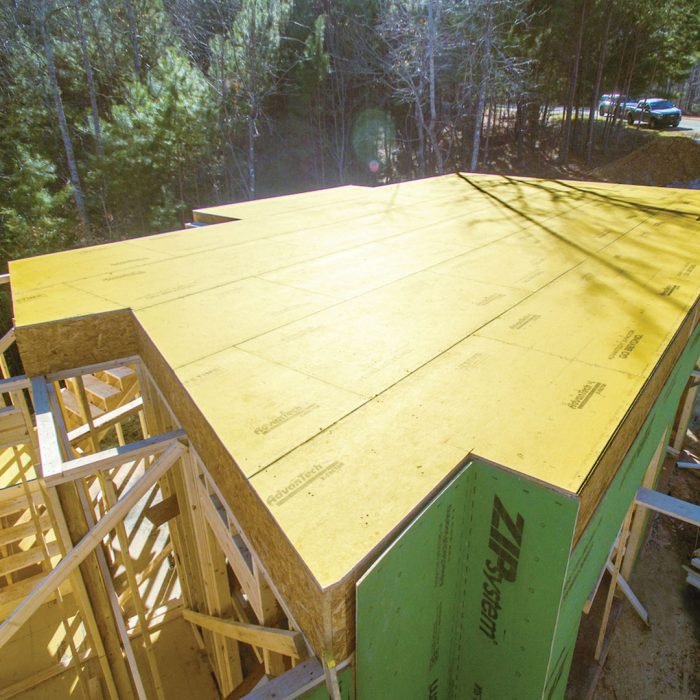 |
Photos courtesy of the manufacturers.
This list is not exhaustive, but here are a few problem-solving subflooring products you can consider for your work. Remember, prices are regional and change often. We’ve included them simply to give you an idea of the general price point the manufacturers are shooting for. While I was writing this article, commodity subflooring with the APA’s Sturd-I-Floor designation sold at lumberyards and home improvement stores for under $25 for a 3⁄4-in.* sheet of OSB and about $50 per sheet for plywood.
Diamond Premium Subflooring Shoots for Easy Installation
Weyerhaeuser’s Diamond Premium Floor Panels focus on an easy-fit tongue-and-groove edge for hassle-free installations. They control OSB edge swelling with a novel mechanical solution, “Down Pore,” which consists of three specially shaped drainage grooves on one of the narrow ends of each 4×8 panel. The design resists clogging from sawdust or adhesive and drains water even if the panels are not correctly gapped. According to the manufacturer, Down Pore eliminates the need to sweep pooled rainwater off the floor or drill holes to let it through. The panels are available in a 23⁄32-in. thickness, and have a limited lifetime warranty and a 500-day no-sand guarantee.
Diamond $53 per sheet at Millard Lumber
Durastrand Edges can Accomodate Swelling
As a hedge against edge swell, West Fraser manufactures a premium subfloor under the Durastrand PointSix brand that features a nominal 0.6-mm taper on the panel edges designed to allow for a bit of swelling without ridging at panel seams. The company offers the product in 19⁄32-in., 23⁄32-in., 7⁄8-in., and 1-1⁄8-in. thicknesses, depending on the market. West Fraser also sells Stabledge premium subflooring, which the company guarantees will never swell, in 19⁄32-in., 23⁄32-in., and 7⁄8-in. thicknesses. Both products come with 50-year limited warranties and no-sand guarantees.
Durastrand PointSix $37 per sheet at Menards
Stabledge $55 per sheet at Kent
LP Focuses on Strength and Durability
Both of LP’s branded subfloor products offer a drainage system to prevent swelling at the panel edges. Their Legacy subfloor includes rain channels, and their more affordable TopNotch 350 subfloor has notches along the tongue that provide drainage. Both are available in a number of thicknesses up to 1-1⁄8 in. Legacy is LP’s premium product and boasts increased strength compared to commodity OSB subflooring. Both products are self-spacing along the tongue-and-groove edge. LP says that both of these subfloor options are carbon-negative.
Legacy $40 per sheet at The Home Depot
TopNotch 350 $44 per sheet at BMR and Agrizone
Georgia Pacific Still Offers Plywood Pptions
Georgia Pacific is one of the few manufacturers still promoting plywood subflooring. GP’s Plytanium plywood sheathing has more than 50 years on the market. The company also makes DryPly, a water-repellent treated Sturd-I-Floor panel that testing shows absorbs 40% less moisture than untreated panels. However, the company’s premium subfloor is DryMax, an OSB panel GP sells as their “most moisture-resistant subfloor,” backed by a 500-day no-sand warranty. GP offers all three products as straight-edge and tongue-and-grove panels from 19⁄32 in. to 1-1⁄8 in. thick.
Plytanium $80 per sheet at Lowes
DryPly $60 per sheet at Lowes
DryMax $44 per sheet at Lowes
Huber Has a Product for Every Project
With a 200-day no-sanding guarantee, Blue Plus is Huber’s step up from commodity OSB subfloor sheathing and comes in just one 23⁄32-in. thickness. Huber’s next step up, AdvanTech, is available in four thicknesses from 19⁄32 in. up to 1-1⁄8 in., and the company says it is stronger, more durable, and easier to install than most subfloors. When Huber introduced AdvanTech subflooring, they called it “the flat out best.” But today, they have something better: X-Factor, which takes the AdvanTech line another step into the future with a water-resistive overlay for increased durability and slip resistance.
Blue Plus $38 per sheet at Lowes
AdvanTech $51 per sheet at Schillings
AdvanTech X-Factor $74 per sheet at Hancock Lumber
— Fernando Pagés Ruiz; builder and an ICC-certified residential building inspector active in code development.
From Fine Homebuilding #324
RELATED STORIES
- Getting a Stiff Floor From the Right Subfloor Sheathing
- Subfloor Sheathing
- Extend Your Reach When Laying Subfloor
Fine Homebuilding Recommended Products
Fine Homebuilding receives a commission for items purchased through links on this site, including Amazon Associates and other affiliate advertising programs.

Affordable IR Camera

8067 All-Weather Flashing Tape

Handy Heat Gun






















